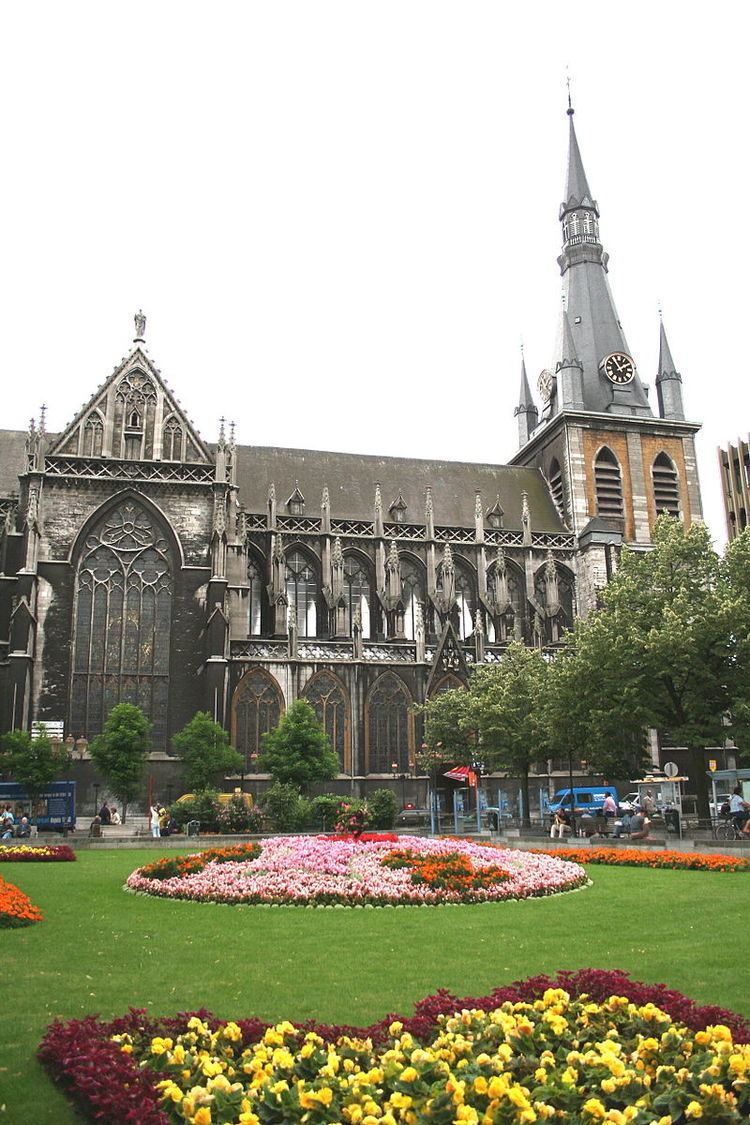Ecclesiastical province Mechelen-Brussels Phone +32 4 230 31 50 | Denomination Roman Catholic Area 3,862 km² | |
 | ||
Metropolitan Archdiocese of Mechelen-Brussels Population- Total- Catholics (as of 2013)1,054,000721,000 (68.4%) Address Rue de l'Evêché 25, 4000 Liège, Belgium | ||
The Roman Catholic Diocese of Liège (Latin: Dioecesis Leodiensis) is a diocese of the Latin Rite of the Roman Catholic church in Belgium. The diocese was erected in the 4th century, and has a long and complicated history. Currently the diocese is a suffragan of the Archdiocese of Mechelen-Brussels. Its modern version covers the same territory as the Belgian province of Liège, but it was historically much larger.
Contents
Origins of the diocese
The original diocese was the church equivalent of the Civitas Tungrorum, the capital of which was Tongeren, northwest of Liège, and its borders were probably approximately the same.
The bishopric of Tongeren originally formed part of the dioceses of Trier and Cologne. After the first half of the fourth century, the bishopric of Tongeren received autonomous organization. In late antiquity, the centre of administration and religion in the area moved first to Maastricht, and then to Liège.
The boundaries were formed, to the North, by the diocese of Utrecht; to the East, Cologne; to the South, the dioceses of Trier and Reims; to the West, that of Cambrai. Thus the diocese of Tongeren extended from France, in the neighbourhood of Chimay, to Stavelot, Aachen, Gladbach, and Venlo, and from the banks of the Semois as far as Ekeren, near Antwerp, to the middle of the Isle of Tholen and beyond Moerdijk, so that it included both Romance and Germanic populations. The boundaries remained virtually unchanged until 1559.
Legend has it that the first bishop of Tongeren was Saint Maternus. This may refer to the legendary founder of the Archbishopric of Cologne, Maternus I, or Saint Maternus (Maternus II), who was also bishop of Cologne. Saint Servatius was the first confirmed bishop of Tongeren-Maastricht-Liège, who was referred to in documents as bishop of the Tungri. He died around 384 and was buried outside the Roman castrum in Maastricht. One of his successors, probably in the 6th century, moved the see of the bishopric to Maastricht. The conversion of the Franks continued under Falco (around 500 AD) and continued under Saint Domitian, Saint Monulphus and Saint Gondulphus (6th/7th centuries). Monulphus built a church over the grave of Saint Servatius in Maastricht, which later became the Basilica of Saint Servatius. During the whole of the seventh century the bishops had to struggle against paganism and opposition. St Amandus (647–650) and St Remaclus (650–660) even abandoned the episcopal see in discouragement. Both built several monasteries. St Theodard (660–669) died a martyr.
St Lambert (669–700) completed the conversion of the pagans in the Ardennes region. He was murdered at Liège around 705. Lambert was regarded as a martyr for his defence of church property against the avarice of the neighbouring lords. His successor, St Hubert, transferred the body of St Lambert to Liège, which was then a small settlement, a vicus, named Vicus Leudicus. On his grave Hubert built a chapel (St. Lambert's Cathedral) which became the nucleus of the city, and near which the permanent residence of the bishops was established.
Agilbert (768–784) and Gerbald (785–810) were both appointed by Charlemagne. Hartgar built the first episcopal palace. Bishop Franco, who defeated the Normans, is celebrated by the Irish poet Sedulius Scottus. Stephen (908–920), Richaire (920–945), Hugh (945–947), Farabert (947–958) and Rathier were promoted from the cloister school. To Stephen, a writer and composer, the Catholic Church is indebted for the feast and the Office of the Blessed Trinity. Ratherius absorbed all the learning of his time. Heraclius, who occupied the see in 959, built four new parish churches, a monastery, and two collegiate churches, he inaugurated in his diocese an era of great artistic activity known as Mosan art.
All these bishops, until the end of the Middle Ages, continued to call themselves bishops of the church of Tongeren, or sometimes bishops of Tongeren-Maastricht or Tongeren-Liège, Tongeren in this case referring to the old civitas of Tongeren, rather than the town.
Modern History
The original dioceses of the region underwent some adaptations under Habsburg influence in 1559, and then survived further until suppression under the Revolution, and confirmed in 1801 by a Concordat co-signed by Napoléon Bonaparte and Pope Pius VII. The new diocese, erected 10 April 1802, included the two départements of Ourte and Meuse-Inférieure, with certain parishes of the département des Forêts. In 1818, it lost a certain number of cantons, ceded to Prussia.
After the establishment of the United Kingdom of the Netherlands the two provinces of this diocese were renamed as Liège and Limburg. On 6 May 1838, Mgr Van Bommel divided the Province of Liège into two deaneries. In 1839, the diocese lost those parishes which were situated in Dutch Limburg, which was no longer part of Belgium. In 1967, the Dutch-speaking parishes of the diocese formed the newly erected Diocese of Hasselt, corresponding to Belgian Limburg. From that point, the present territory of the diocese has coincided with the Province of Liège. The present Diocese of Liège, suffragan to the Archdiocese of Mechlin–Brussels, consists of 525 parishes with 543 priests and has a population of 1,023,506 (as of 2003), the majority (Walloons) speaking French; the minority, German in the German-speaking Community of Belgium.
